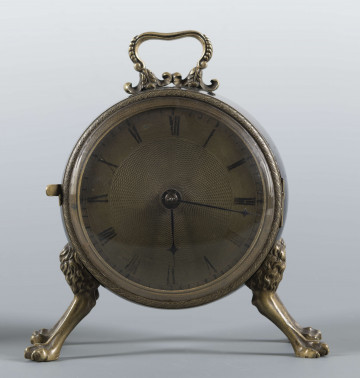
Cabinet clock
1790 — 1800
National Museum in Lublin
Part of the collection: Clocks
Mechanical clocks appeared in Poland in the 2nd half of the 14th century. At first, the mechanism was moved by a weight suspended on a string wound on a wooden shaft. The string length determined how long the sundial lasted, so the oldest clocks were placed on church towers. The invention of the spring, combined with a device to compensate for tension, created unlimited possibilities for shaping the form at the turn of the 14th and 15th centuries. The force of habit meant that domestic clocks also resembled miniature towers at first, but soon other forms appeared. Brass mechanisms replaced iron ones, and the cases changed from round cans to square or hexagonal ones, and through the glass windows one could watch the mechanism work and admire its ornamental elements. Because of their shape, they came to be known as tile clocks, and when they gained legs, a more familiar term emerged – the frog. Tiled clocks are the crowning achievement of Polish watchmakers as superb in design, durable, and very impressive works of art. Candidates for the post of clockmaker were required to build a tiled clock, which, apart from time, would show, with accuracy to the second, the movement of the sun in the zodiac, the quadrants of the moon, the hours and quarters of an hour. Jakub Gierke met these requirements.
The dates of his life are unknown, but he was active in Vilnius between 1616 and 1660. His family came from Germany but was quickly Polonised. Jakub Gierke's clocks are very diverse, and we should remember that changing the size and shape of the case or setting the mechanism from vertical to horizontal required excellent knowledge of mechanics and mathematics, as well as skilful hands to breathe life into a lump of metal. Michał Brensztejn ('Ateneum Wileńskie' 1923) had no doubts that 'above all Vilnius watchmakers of the 17th century, there is one true artist whose name has been preserved on [...] masterpieces of clock-making art that have fortunately survived to our times: Jakub Gierke'.
Barbara Czajkowska
Author / creator
Dimensions
cały obiekt: height: 17,5 cm, width: 10 cm
Object type
goldsmith's art
Technique
carving
Material
brass, steel
Creation time / dating
Creation / finding place
Owner
The National Museum in Lublin
Identification number
Location / status

1790 — 1800
National Museum in Lublin

2nd half of the 19th century
National Museum in Lublin

1801 — 1810
National Museum in Lublin
DISCOVER this TOPIC
National Museum in Szczecin
DISCOVER this PATH
Educational path